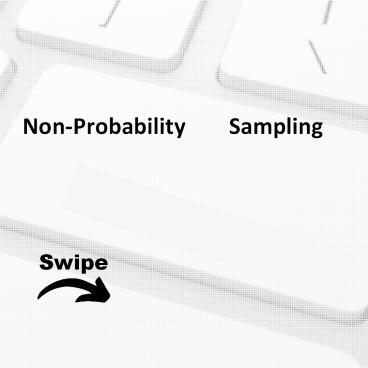Non-Probability Sampling - PowerPoint PPT Presentation
Title:
Non-Probability Sampling
Description:
This presentation educates you about Non-Probability Sampling, Types of non-probability sampling, When to use non-probability sampling?, Advantages of non-probability sampling and difference. For topics stay tuned with Learnbay. – PowerPoint PPT presentation
Number of Views:64
Title: Non-Probability Sampling
1
Non-Probability Sampling
Swipe
2
Non-Probability sampling
Non-probability sampling is defined as a sampling
technique in which the researcher selects
samples based on the subjective judgment of the
researcher rather than random selection. It is
a less stringent method. This sampling method
depends heavily on the expertise of the
researchers. It is carried out by observation,
and researchers use it widely for qualitative
research.
3
Non-probability sampling is a sampling method in
which not all members of the population have an
equal chance of participating in the study,
unlike probability sampling. Each member of the
population has a known chance of being
selected. Non-probability sampling is most
useful for exploratory studies like a pilot
survey Researchers use this method in studies
where it is impossible to draw random
probability sampling due to time or cost
considerations.
4
Types of non-probability sampling
Convenience sampling Consecutive sampling Quota
sampling Judgmental or Purposive sampling
Snowball sampling
5
When to use non-probability sampling?
Use this type of sampling to indicate if a
particular trait or characteristic exists in a
population. Researchers widely use the
non-probability sampling method when they aim at
conducting qualitative research, pilot studies,
or exploratory research. Researchers use it when
they have limited time to conduct research or
have budget constraints. When the researcher
needs to observe whether a particular issue
needs in-depth analysis, he applies this
method. Use it when you do not intend to generate
results that will generalize the entire
population.
6
Advantages of non-probability sampling
Non-probability sampling techniques are a more
conducive and practical method for researchers
deploying surveys in the real world. Although
statisticians prefer probability sampling because
it yields data in the form of numbers, however,
if done correctly, it can produce similar if not
the same quality of results.
7
Getting responses using non-probability sampling
is faster and more cost-effective than
probability sampling because the sample is known
to the researcher. The respondents respond
quickly as compared to people randomly selected
as they have a high motivation level to
participate.
8
Difference
- Probability sampling
- The sample is selected at random.
- Everyone in the population has an equal chance
of getting selected. - Used when sampling bias has to be reduced.
Useful when the population is diverse. - Used to create an accurate sample. Finding the
right respondents is not easy.
9
Difference
Non-probability sampling Sample selection based
on the subjective judgment of the
researcher. Not everyone has an equal chance to
participate. The researcher does not consider
sampling bias. Useful when the population has
similar traits. The sample does not accurately
represent the population. Finding respondents
is easy.
10
Topics for next Post
Sentimental Analysis cloud computing Stay Tuned
with































